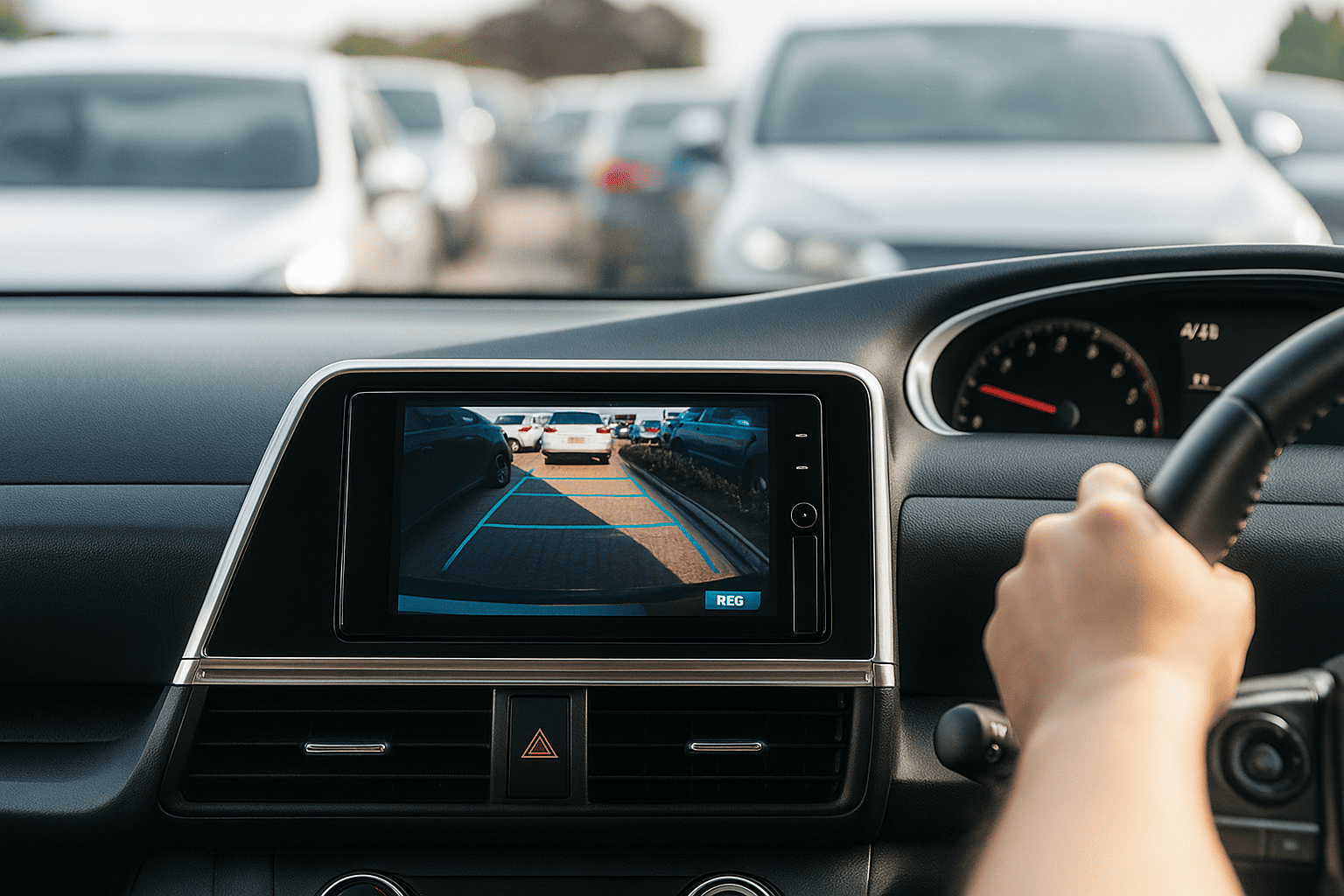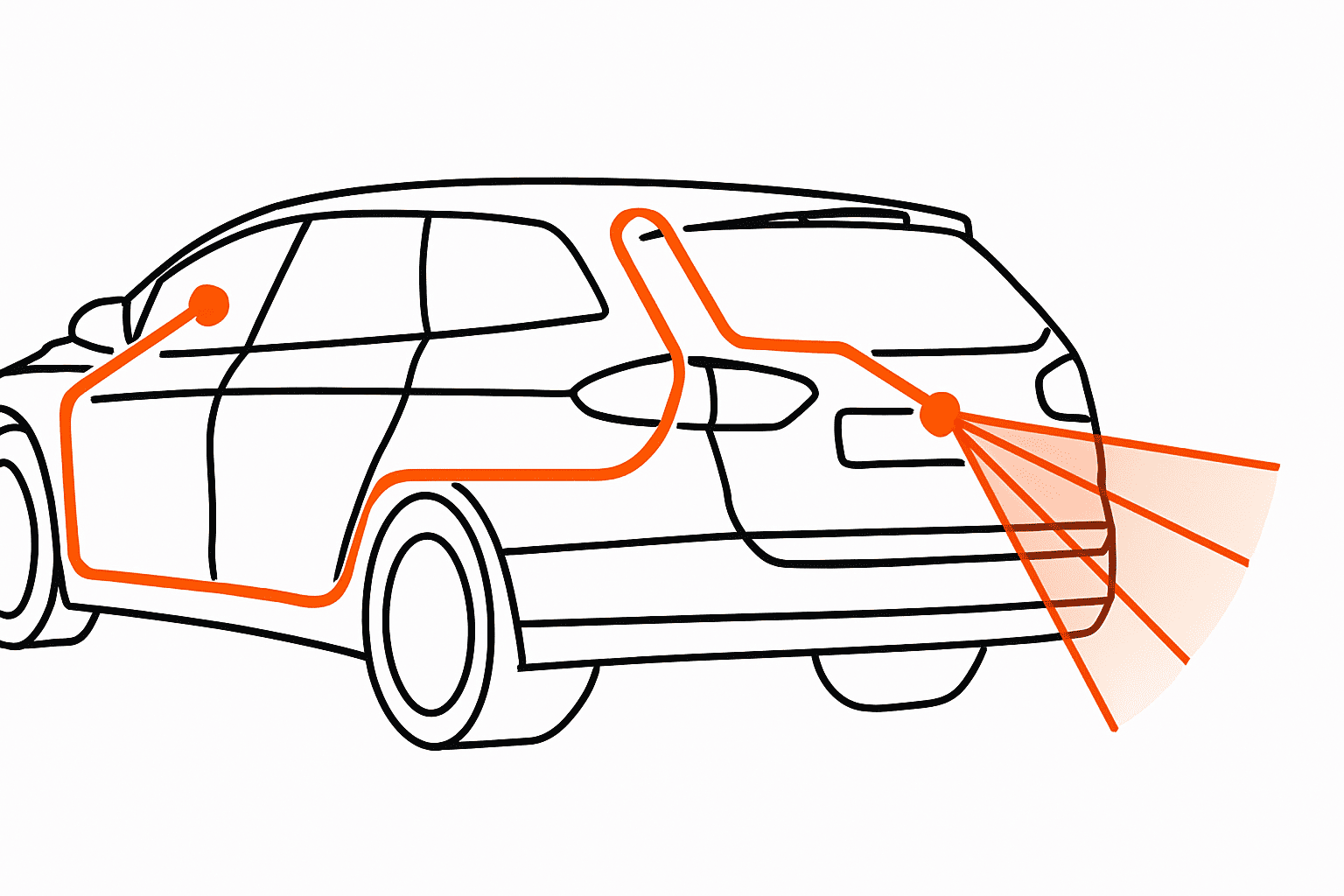Table of Contents
How to choose the best reversing camera for your car
Not too long ago, a reversing camera was an expensive, luxury feature that was only available for certain models. It is gradually becoming an industry standard and is now a legal requirement for new vehicles in some countries like the US and Canada. The reason for this is quite simple: it’s useful and effective.
By giving you a clearer view of what’s going on behind you, a reversing camera can help you avoid a collision in the tightest of parking spots. While it is helpful for ensuring safety when reversing and manoeuvring, it can also help to increase the confidence of new drivers.
This guide will help you understand how reversing cameras work, what features to look for, and which type is best suited to your vehicle and driving habits.
What does a reversing camera do?
A reversing camera, also referred to as a backup or reverse camera, provides a real-time visual of the area directly behind your vehicle. It activates automatically when you shift into reverse gear, giving you a wide-angle or fisheye view on a dashboard screen or smartphone.
The system uses either a Charge-Coupled Device (CCD) or Complementary Metal-Oxide Semiconductor (CMOS) sensor to capture the image. These sensors differ in image processing, with CCD generally offering better performance in low light, while CMOS models tend to be more affordable and power-efficient.
Many systems can be integrated with other driver assistance features such as parking lines, cross-traffic alerts, or even a full 360-degree surround view. For even greater situational awareness, pairing your system with car parking sensors can provide both visual and audible cues when you’re close to an obstacle.

Types of reversing cameras
When browsing for a reversing camera for your car, understanding the available types will help you choose one that suits your driving needs and technical and installation preferences.
➤ Reversing cameras with night vision
If you frequently drive at night or in low-light conditions, consider a model that features infrared LEDs or superior low-light image sensors. These cameras enhance visibility in the dark and reduce your reliance on ambient light or rear headlights alone.
➤ Rear view camera with mirror image capability
This means the image is horizontally flipped to resemble what you would see through your rear view mirror. Some advanced units even allow you to switch between the mirror view and the normal view, which is particularly helpful for orientation. However, some drivers find the LED mirror screen offputting.
➤ Wired vs. wireless reversing cameras
Both wired and wireless models have their pros and cons:
- Wired systems deliver a stable connection and high-resolution video feed, making them suitable for larger vehicles or frequent drivers. However, installation often requires running cables through the vehicle, which can be time-consuming and costly.
- Wireless systems, on the other hand, are simpler to install as they transmit video via WiFi or Bluetooth. They’re ideal for drivers looking to avoid invasive installation, though signal interference or latency may occur if the transmitter and receiver are too far apart or obstructed by dense materials. Some models can connect directly to your smartphone, making them incredibly convenient.
Whichever type you choose, make sure it’s compatible with your vehicle’s infotainment system or that it includes its own monitor.

Which reversing camera is best for my car?
Choosing the best reverse camera for your car isn’t just about the lens or image quality, it’s about how it integrates with your car and your driving needs. AUTODOC experts emphasise the importance of considering the following factors:
▶ Installation style
The mounting method can significantly influence the camera’s field of view, installation effort, and aesthetics. Here are the most common types:
- Number plate mount: these are among the easiest to install, often requiring no drilling. However, their lower placement may restrict the field of view.
- Surface mount: these cameras attach to a flat surface, such as the rear bumper or boot lid, offering a higher vantage point and wider angle.
- Flush mount: this type involves embedding the camera directly into the car’s body. While this offers a clean, factory-style finish, installation typically requires drilling.
- Bracket mount: attached using adjustable brackets, these cameras offer flexible angles and are ideal if you want precise control over your viewing field.
When selecting a product, consider not only how it will look on your vehicle but also how much of the surroundings it can realistically show.




▶ Viewing angle and resolution
Look for a camera with at least a 120° viewing angle. Anything narrower may leave blind spots behind your vehicle. High-resolution cameras, typically 720p or higher, ensure that you get a clear image that can help you better detect pedestrians, bollards, or kerbs.
If your budget allows, models with HD or full-HD output offer sharper images, especially when paired with a compatible display.
▶ Compatibility and connectivity
Not all systems are plug-and-play. Some may require specific interfaces or adaptors to connect to your in-car display. Others may come with a standalone screen that mounts to your dashboard or replaces the existing rear-view mirror. Always verify whether the system supports your car’s voltage and operating requirements before making a purchase.
Brand quality and trust
Given the safety role that a reversing camera plays, choosing a reliable brand is important. Look for manufacturers that comply with OE standards and offer warranty support. Accuracy is also highly important, so you need a product with good quality sensors. For example, the Pioneer reversing camera is a popular choice, known for its high-definition image output and easy integration with popular audio-visual systems.
Reading customer reviews and checking third-party tests can also give you insight into ease of use, video quality, and long-term performance. Avoid unbranded or poorly reviewed models as they may fail when you need them most.





Bonus features to consider
Some reverse camera systems go beyond the basics, offering additional enhancements that can further improve your driving experience:
- Dynamic parking lines: these move as you turn the wheel, helping you better judge trajectory and distance.
- G-sensor or dashcam integration: some cameras double up as recorders, capturing video while you drive or park.
- Waterproof ratings: a camera with an IP67 or IP68 rating is ideal for withstanding rain, snow, and road grime.
- Split-screen mode: useful for systems with multiple cameras (rear and side views), especially on large vehicles like vans or campervans.
Should I install it myself or hire a professional?
For wired systems or flush-mount installations, it’s often worth hiring a professional. This ensures correct alignment, secure connections, and protection against water ingress or interference with existing vehicle electronics. Wireless systems, however, are usually much easier to install yourself by carefully following online tutorials or written instructions.
To learn more about setting up your system properly, you can check out our dedicated guide on how to install a reverse camera.
Frequently Asked Questions (FAQ)
Yes, most reversing cameras function in rain and fog, but visibility may be reduced. Choosing a model with a waterproof rating (like IP67) and anti-fog coating can improve performance in poor weather conditions.
Some systems allow continuous camera feed, which can be helpful for towing or monitoring loads. This feature depends on the camera model and how it’s wired into your vehicle’s system.
Yes, some models are compatible. Many aftermarket kits are designed specifically for retrofitting older vehicles, and they often come with universal mounts or wireless connectivity for easier installation.
Top products related to this topic:











